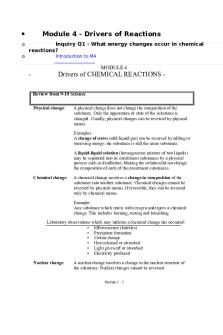ASM 275 Study Guide module 4 chapter one PDF

| Title | ASM 275 Study Guide module 4 chapter one |
|---|---|
| Course | Medical Anthropology |
| Institution | Arizona State University |
| Pages | 2 |
| File Size | 90.1 KB |
| File Type | |
| Total Downloads | 94 |
| Total Views | 150 |
Summary
Study guide for chapter four, module one. It prepares you for the exam and will help you succeed....
Description
ASM 275: Forensic Anthropology Exam 4 Study Guide
What is positive identification and individuation? Pathology (Lecture 19): What is it? How is it useful to forensic anthropologists? *What can past patterns of trauma tell us about the individual? *What can diet and health conditions tell us? *What can congenital disease malformations tell us? *What can infections diseases tell us? *What can neoplasms tell us? *What can rare bone diseases tell us? Know the examples of each of the above that we went over in class! Know the three ways pathology affects bone and the terms lytic, osteoclastic, and osteoblastic Be familiar with the following terms: anemia, cribra orbitalia, porotic hyperostosis, linear enamel hypoplasia (LEH), Harris lines, arthritis, tuberculosis, leprosy, syphilis (treponemal infections). Non-specific stress markers- what are they and what do they tell us? What is "stress"? Occupational Stress Markers (Lecture 20) *Know what they are and why they are useful to forensic anthropologists. *Know the four "classes" of the markers 1) modifications to areas of muscle insertion 2) osteophytosis 3) discrete markers – squatting facets, dental attrition, habitual pipe-smoking, etc 4) stress fractures *How accurate are these methods? Radiography –how can it be used to ID individuals? (Lecture 21) *Comparison of ante-mortem records * Looking for odd variants or variation in frontal sinus pattern; difficulties involved in looking at the frontal sinus Forensic Odontology: (Lecture 22; Rothwell article) Know what it is and the two general uses of it *Matching of dental records to remains (dental anatomy and pathology—how is this used in personal identification? *Bite mark analysis—what is it? -Ted Bundy
1
Anatomical variants: (Lecture 21) *What can they provide information on? *How are they forensically useful? *Know examples (e.g., metopic suture, extra-sutural bones in cranium, extra digits Intentional Cultural Modification (Lecture 21) *How is this forensically useful? *Know examples (foot binding, corset training, artificial cranial deformation, intentional tooth removal, etc.) Handedness: (Lecture 21) *Why is this forensically useful? *What specific indicators are used to assess handedness? Body Weight: (Lecture 21) *What goes into estimation of body weight from bones? *How accurate are body weight estimations? Facial Reconstruction: (Lecture 23) *What is it and why do we do it? *Know the techniques discussed in class (and in the film we saw) and difficulties involved. Human Rights Investigations: (Lecture 24; Fulginiti article) *Types of war crimes *Genocide—what constitutes it? What two elements are involved in this crime? *What are the goals of human rights investigations? Biohistorical case studies: know the basic details of each. (Lecture 25; Helmer article; Ubelaker et al article, Park et al article, Stojanowski and Duncan article)
2...
Similar Free PDFs

Module 4 study guide
- 36 Pages

Chapter 4 Study Guide
- 4 Pages

Chapter 4 Study Guide
- 11 Pages

Chapter 4 Study Guide
- 9 Pages

Chapter-4 study guide
- 45 Pages

Chapter 4 Study Guide
- 9 Pages

Chapter 4 Study Guide
- 4 Pages

CASE Study ASM 453 - asm
- 17 Pages

Exam One Study Guide
- 47 Pages

Exam One Study Guide
- 15 Pages

Study Guide for Chapter 4
- 4 Pages

Chapter 4 Review - study guide
- 7 Pages

Module #4, PP IV Study Guide
- 16 Pages

Module 7 study guide
- 5 Pages
Popular Institutions
- Tinajero National High School - Annex
- Politeknik Caltex Riau
- Yokohama City University
- SGT University
- University of Al-Qadisiyah
- Divine Word College of Vigan
- Techniek College Rotterdam
- Universidade de Santiago
- Universiti Teknologi MARA Cawangan Johor Kampus Pasir Gudang
- Poltekkes Kemenkes Yogyakarta
- Baguio City National High School
- Colegio san marcos
- preparatoria uno
- Centro de Bachillerato Tecnológico Industrial y de Servicios No. 107
- Dalian Maritime University
- Quang Trung Secondary School
- Colegio Tecnológico en Informática
- Corporación Regional de Educación Superior
- Grupo CEDVA
- Dar Al Uloom University
- Centro de Estudios Preuniversitarios de la Universidad Nacional de Ingeniería
- 上智大学
- Aakash International School, Nuna Majara
- San Felipe Neri Catholic School
- Kang Chiao International School - New Taipei City
- Misamis Occidental National High School
- Institución Educativa Escuela Normal Juan Ladrilleros
- Kolehiyo ng Pantukan
- Batanes State College
- Instituto Continental
- Sekolah Menengah Kejuruan Kesehatan Kaltara (Tarakan)
- Colegio de La Inmaculada Concepcion - Cebu

